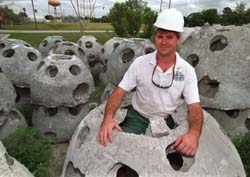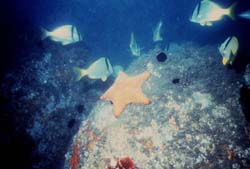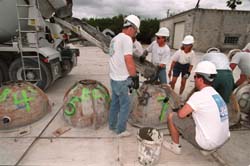
|
|
You can fool Mother Nature By Cherie Jacobs Lane Todd Barber is banking on something fishy happening. Well, actually, many things fishy.
Reef balls are dome-shaped concrete blobs, with Swiss cheese-like holes. The concrete's uneven surfaces encourage the growth of algae, barnacles and coral. The holes allow fish to congregate and hide - and escape bigger fish. ``What we want to do is mimic Mother Nature,'' Barber said.
Barber, an avid scuba diver since he was 15, came up with the idea for reef balls several years ago because he wanted to dive near something more realistic-looking than what was available. Often artificial reefs are old train cars, sunken ships or crumbled bridges. ``You see these, basically, trash heaps that you're diving on,'' he said. ``We were tired of looking at square boxes or ships. We just wanted to have real reefs.'' He and about 15 of his diving and college buddies spent a week working on the first reef balls in 1992. Now, they have perfected the design and created Reef Ball Development. Barber moved the company from Atlanta, where most of the people lived, to south Manatee County in August because of its access to the Gulf of Mexico and because he preferred it to Florida's east coast. Underwater dumps Most artificial reefs, as Barber says, are glorified garbage heaps. If you put anything in the water, things will grow on it, scientists said. `` `What do we have and we want to get rid of that we can make a reef out of?' '' said Jim Culter, a staff scientist with Mote Marine Laboratories who specializes in the sea bottom. Typically, reefs are formed from concrete drainage culverts, old boats, junk cars, fiberglass boat molds, old ships, tires, even washing machines. But metal rusts. Wood dissolves. Fiberglass and tires float around too much. For creating a long-term reef, none of those materials is ideal. About five years ago - just as Barber and his buddies were forming Reef Ball Development - researchers began realizing that the best reefs weren't made of junk tossed into the water, but objects that were specifically intended to become reefs. ``Reef Ball got lucky to come up with an idea just as the scientists were telling us this was a good idea,'' said Mike Solum, an environmental specialist who runs Sarasota County's reef program. Barber chuckles at the thought. ``Part of that was just good timing,'' Barber said. ``And part of that was doing good market research. There's been people out there with ideas like this, but you've got to have an economic reason to push (it).''
``They're more expensive than just having concrete rubble donated to you,'' said John Stevely, Florida Sea Grant extension agent for Sarasota and Tampa bays. ``(But) I am fairly well convinced that they are a better reef material than simple concrete rubble. Reef Balls do provide spaces and holes.'' Plus, with concrete rubble, a barge is needed to haul it into the water, and officials have no control over the final height or shape of the pile. Reef balls are far more portable. With inflatable buoys, reef balls can be towed by a small boat. Deflate one of the buoys and the reef ball sinks to the bottom. Even the large ones - at 4,000 pounds - can be towed with buoys by a canoe or water scooter, Barber said. Reef balls are good in shallow water, and concrete lasts longer than old tires or rusting ships. ``If you're using taxpayer dollars, there's (got to be) a guarantee that those materials are going to last for a minimum of 20 years,'' Solum said. ``Boxcars don't do that. Old boats don't do that. Sunken ships don't do that. Concrete does.'' Barber said he's sure his reef balls will last a minimum of 500 years. Diving dilemma Barber and his dad were vacationing in the Cayman Islands, lamenting the decline of reefs in the late 1980s. They came up with an idea for a new kind of reef. They wanted to cover a beach ball with concrete, float it out to sea, and pop the beach ball, sinking it to the bottom. But would it work? Barber, then a business consultant, and his dad, who owned an amusement park-ride company, worked with some engineers and scientists they knew to perfect the idea. In July 1992, they conducted an experiment. They spent a week in West Palm Beach trying to bring their idea
into reality, working with what is now the Florida Department of
Environmental Protection. Sixteen people spent the week drinking
beer and wrapping chicken wire around beach balls.
It took them all week, but they made three primitive reef balls. The balls weren't stable enough - they were round and rolled a bit. But they worked. For the next six months, Barber attended artificial reef coordinator meetings, which taught him the basics of reef-building. For another two years, the men refined the design into the current reef ball. Now the reef ball is dome-shaped and heavy, stable enough to survive a hurricane. It is patented and copyrighted. The company has become skilled at handling the complicated permit process. It also has streamlined production, using pH-balanced concrete, though some scientists dispute whether that's really necessary. Although they are uniform in shape, no two reef balls are identical because the holes are made individually. The holes - called vortex holes, which means they create tiny whirlpools - are created by putting inflatable objects into the wet cement, such as balls and rubber gloves.
Reef Ball Development gets 10 percent of the contractors' sales. That money pays for running the office and for marketing. The contractor arrangement works well for the company. For example, Sarasota County opened a bid earlier this month for 200 reef balls to be placed six miles off New Pass. Five contractors bid on the project, and no matter which company won - Coastal Reef Builders in Pensacola was the lowest bidder - Reef Ball Development would benefit. ``It was kind of a labor of love when we got into it,'' said Jay Jorgensen, office manager. ``We never expected to make any money on it.'' So far they haven't. Their original goal was to put as many artificial reefs under water as they could. The company has broken even for the past two years, Barber said. The company has repaid the people who contributed money to its startup - Barber spent $56,000, which he has gotten back. Tecnically the company has no employees because none of the 25 people involved in it is paid. Most of them are in Atlanta. Three people run the one-room office in south Manatee County, which fronts Sarasota Bay about two miles from Sarasota-Bradenton International Airport. Barber hopes this year will be the first that the company turns a profit. He said it could also be the first that the firm's officers pay themselves salaries, depending on finances. They are counting on growth in international business, which makes up 70 percent of their sales, Barber said. Many foreign clients buy reef balls through the company's Web site and communicate with it solely through electronic mail. And as more governments in waterfront communities turn to specially designed reefs, Barber is hoping for more grant-sponsored projects such as the one awarded to Sarasota County earlier this month. Sarasota will receive $25,000 this summer from the DEP to add 200 reef balls to the 450 already under water. The new reef balls will be placed in the Gulf, where they will link a series of old military tanks that were sunk several years ago. The county and Mote have also applied for another $25,000 grant from DEP to put 50 reef balls as part of a project to repair the dredged bottom of Sarasota Bay. With numerous projects nearby, Barber can visit reef balls that have been under water for a while, to see the progress. ``It's absolutely awesome,'' Barber said. ``We see fish everywhere, growth. It really makes you feel good. ``It's just sheer wonderment,'' Barber said. ``Remember when you were a kid and you were in the woods, you're 5 years old and your grandpa's holding you by the hand. `Oh, that's a butterfly.' There's always something new around every turn. It's impossible to think about 9-to-5, or anything else.'' INTERESTED? Is your scout troop or non-profit group interested in starting a reef? The Reef Ball Foundation provides molds at no cost. You provide the concrete and the labor. To apply electronically, go to the foundation's web site at www.reefball.org, or call (941) 752-0169. Story Filed By The HERALD TRIBUNE, SARASOTA, FLORIDA NYT-04-05-98 2112EDT< |

 Barber,
34, is president of Reef Ball Development, a young company that has
created an unusual object to be used under water as an artificial
reef. What started out as an environmental hobby has grown into a
business that has attracted customers from around the world.
Barber,
34, is president of Reef Ball Development, a young company that has
created an unusual object to be used under water as an artificial
reef. What started out as an environmental hobby has grown into a
business that has attracted customers from around the world.
 About
1,000 of Barber's reef balls are in the waters off Manatee, Sarasota
and Charlotte counties. Another 1,000 will be added this year. About
40,000 reef balls are under eight oceans, seas or gulfs around the
world.
About
1,000 of Barber's reef balls are in the waters off Manatee, Sarasota
and Charlotte counties. Another 1,000 will be added this year. About
40,000 reef balls are under eight oceans, seas or gulfs around the
world.
 Reef
balls vary in size, but the most common ones start at $80 for a
small one that is 3 feet wide and 2 feet tall, and go up to $300 for
a large one, that is 6 feet wide and 4 feet tall.
Reef
balls vary in size, but the most common ones start at $80 for a
small one that is 3 feet wide and 2 feet tall, and go up to $300 for
a large one, that is 6 feet wide and 4 feet tall.
 The
company has 12 certified contractors, such as concrete or barge
companies, that pour the molds and ship the reef balls. Four of the
contractors are in Florida, the closest being Orlando.
The
company has 12 certified contractors, such as concrete or barge
companies, that pour the molds and ship the reef balls. Four of the
contractors are in Florida, the closest being Orlando.